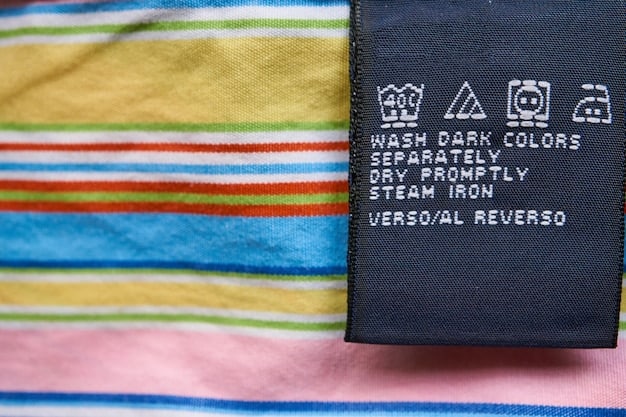Decoding Clothing Labels: A US Consumer’s Guide

Advertisements
Decoding clothing labels is essential for US consumers to understand fabric composition and care instructions, ensuring garment longevity and proper maintenance.
Ever felt lost staring at the cryptic symbols and terms on your clothing labels? You’re not alone! Decoding clothing labels: understanding fabric composition and care instructions for US consumers is a crucial skill for preserving your wardrobe and making informed purchasing decisions.
Advertisements
Why Decoding Clothing Labels Matters
Understanding clothing labels goes beyond simply knowing how to wash your clothes. It’s about making informed choices that impact your wallet, the environment, and the longevity of your favorite pieces. Knowing the fabric composition and care instructions allows you to properly maintain your garments, preventing premature wear and tear.
Furthermore, understanding fabric types helps you choose clothing that suits your lifestyle and climate. For example, breathable cotton is ideal for hot weather, while wool provides warmth in colder temperatures. By decoding labels, you can ensure your clothing remains in top condition for years to come.
Advertisements

Key Components of a Clothing Label
Clothing labels in the US contain a wealth of information, but navigating them can seem daunting. Let’s break down the key components you’ll typically find:
Fabric Composition
This section lists the percentages of different fibers used in the garment. Common materials include cotton, polyester, nylon, wool, and linen. Knowing the fabric composition is crucial for understanding how the garment will feel, drape, and perform.
Care Instructions
These instructions provide guidance on how to wash, dry, iron, and care for the garment. Symbols and text indicate the recommended water temperature, drying method, ironing temperature, and whether dry cleaning is necessary.
Country of Origin
This indicates where the garment was manufactured. While the country of origin doesn’t necessarily reflect the quality of the garment, it can provide insights into labor practices and environmental regulations.
- Understanding Fiber Blends: Blends combine the properties of different fibers, like cotton and polyester for comfort and durability.
- Decoding Care Symbols: Familiarize yourself with washing, bleaching, drying, and ironing symbols for proper garment care.
- Checking for Special Instructions: Some garments may have unique care requirements, such as turning inside out before washing or avoiding certain detergents.
By understanding these key label components, you can confidently care for your clothing and prolong its lifespan.
Understanding Fabric Composition
Fabric composition is a cornerstone of understanding a garment’s properties and care requirements. Different fibers have distinct characteristics that impact how a garment feels, drapes, and withstands wear and tear. Deciphering these components can significantly improve your clothing care routine.
Recognizing common fabrics and their blends is crucial for making informed purchasing decisions. Cotton offers breathability and comfort, while polyester provides durability and wrinkle resistance. Understanding fabric composition helps you choose clothes suitable for various occasions and climates.
Natural Fibers
Derived from plants or animals, natural fibers like cotton, linen, wool, and silk offer unique properties. Cotton is soft and breathable, linen is strong and absorbent, wool provides warmth and insulation, and silk boasts a luxurious feel and drape.
Synthetic Fibers
Man-made fibers such as polyester, nylon, acrylic, and rayon offer durability, wrinkle resistance, and versatility. Polyester is commonly used in blends, nylon provides strength and elasticity, acrylic mimics the feel of wool, and rayon offers a silky texture.
Fiber Blends
Combining different fibers can enhance the properties of a garment, creating a balance of comfort, durability, and performance. Common blends include cotton-polyester, wool-acrylic, and linen-rayon, offering a range of benefits such as wrinkle resistance, enhanced breathability, and improved drape.

Interpreting Care Instructions
Care instructions on clothing labels provide essential guidance on how to maintain your garments properly. Understanding these instructions helps prevent damage, shrinkage, and discoloration, ensuring your clothes stay in excellent condition for longer.
Care symbols follow a standardized system that covers washing, bleaching, drying, ironing, and dry cleaning. Familiarizing yourself with these symbols is crucial for accurately interpreting care instructions and avoiding costly mistakes.
Washing Instructions
These instructions indicate the recommended water temperature, washing cycle, and whether hand washing is necessary. Symbols represent machine washing, hand washing, and specific temperature settings, such as cold, warm, or hot water.
Drying Instructions
Drying instructions specify the preferred drying method, whether machine drying, line drying, or tumble drying. Symbols indicate tumble drying with low, medium, or high heat, as well as line drying or flat drying.
Ironing Instructions
These instructions provide guidance on the appropriate ironing temperature and whether steam ironing is allowed. Symbols represent ironing with low, medium, or high heat, as well as whether steam is permitted or prohibited.
Navigating the FTC’s Care Labeling Rule
The Federal Trade Commission (FTC) enforces the Care Labeling Rule, which mandates that clothing manufacturers provide accurate and permanent care instructions on garments sold in the United States. This rule aims to ensure consumers can properly care for their clothing and avoid damage due to improper handling.
Understanding the Care Labeling Rule helps consumers make informed purchasing decisions and hold manufacturers accountable for providing clear and accurate care instructions. This rule covers a wide range of textile products, including clothing, bedding, and upholstery.
Key Provisions of the Rule
The FTC’s Care Labeling Rule requires manufacturers to include specific information on care labels, such as washing instructions, drying instructions, ironing instructions, and warnings about potential damage from certain care procedures.
Exemptions and Exceptions
Certain types of garments, such as those sold as samples or those with limited value, may be exempt from the Care Labeling Rule. Additionally, some specialized garments with unique care requirements may be subject to specific labeling regulations. Some other items might be subject to variations of the law.
Consumer Rights and Recourse
Consumers have the right to rely on the accuracy of care labels and can seek recourse if garments are damaged due to following incorrect instructions. The FTC provides resources for consumers to report violations and seek resolution.
Tips for Extending the Life of Your Clothes
Extending the life of your clothes not only saves you money but also contributes to a more sustainable lifestyle. Proper care, storage, and handling can significantly prolong the lifespan of your favorite garments. Implementing these tips can make a big difference in preserving your wardrobe.
Investing in quality hangers, using garment bags for storage, and implementing gentle stain removal techniques are all essential for preserving your clothing. Avoiding excessive washing, rotating your wardrobe, and repairing minor damages can significantly extend the life of your clothes.
Washing Wisely
Avoid overwashing your clothes, as excessive washing can cause fading, shrinkage, and wear and tear. Wash garments inside out, use a gentle detergent, and choose the appropriate washing cycle for the fabric type.
Drying Carefully
Avoid high heat when machine drying, as it can damage fibers and cause shrinkage. Line dry delicate items and use a low heat setting for other garments. Remove clothes promptly from the dryer to prevent wrinkles.
Storing Smartly
Store clothes in a cool, dry place away from direct sunlight to prevent fading and mildew. Use padded hangers for delicate items and fold sweaters to prevent stretching. Consider using garment bags to protect clothes from dust and pests.
| Key Point | Brief Description |
|---|---|
| 🏷️ Fabric Composition | Lists fiber percentages (e.g., 100% cotton). |
| 👕 Care Instructions | Washing, drying, ironing guidance. |
| 🌎 Country of Origin | Indicates where the garment was made. |
| 🌱 Natural Fibers | Cotton, linen, wool, silk; derived from plants or animals. |
Frequently Asked Questions
▼
“Machine wash cold” indicates that the garment should be washed in a washing machine using cold water (typically below 85°F or 30°C) to prevent color fading or shrinking.
▼
Ignoring the care label might lead to damage like shrinkage or color bleeding. Taking a moment to check can save your clothes and money in the long run.
▼
“Tumble dry low” means the garment should be dried in a machine dryer using a low heat setting to prevent damage to the fibers and avoid shrinkage.
▼
Clothing labels in the US follow similar guidelines under the FTC’s Care Labeling Rule, but there can be slight variations depending on the manufacturer and the type of garment.
▼
“Dry clean only” signifies the garment should only be cleaned by professional dry cleaning services. Other methods risk damage, color loss, or fabric shrinking.
Conclusion
Decoding clothing labels: understanding fabric composition and care instructions for US consumers is an essential skill for maintaining your clothing and making informed purchasing decisions. By understanding the symbols and terms on clothing labels, you can properly care for your garments, prolong their lifespan, and reduce your environmental impact.